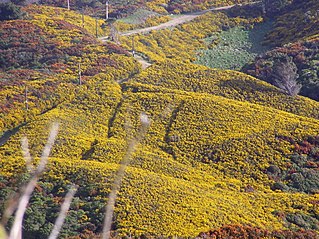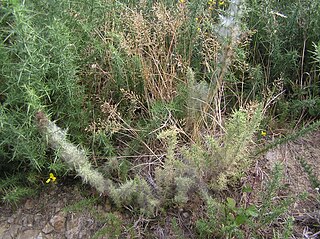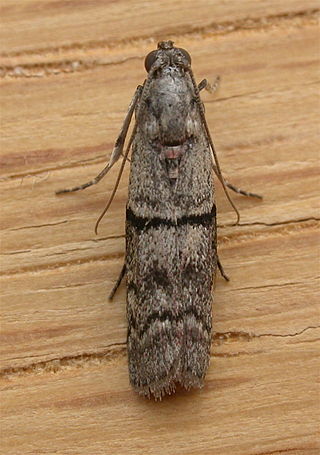
Biological control or biocontrol is a method of controlling pests, such as insects, mites, weeds, and plant diseases, using other organisms. It relies on predation, parasitism, herbivory, or other natural mechanisms, but typically also involves an active human management role. It can be an important component of integrated pest management (IPM) programs.

Lymantria dispar, also known as the gypsy moth or the spongy moth, is a species of moth in the family Erebidae. Lymantria dispar is subdivided into several subspecies, with subspecies such as L. d. dispar and L. d. japonica being clearly identifiable without ambiguity. Lymantria dispar has been introduced to several continents and is now found in Europe, Africa, Asia, North America and South America. The polyphagous larvae live on a variety of deciduous and coniferous trees and can cause severe damage in years of mass reproduction. Due to these features, Lymantria dispar is listed among the world's 100 worst invasive alien species.

Ulex is a genus of flowering plants in the family Fabaceae. The genus comprises about 20 species of thorny evergreen shrubs in the subfamily Faboideae of the pea family Fabaceae. The species are native to parts of western Europe and northwest Africa, with the majority of species in Iberia.

The Pyralidae, commonly called pyralid moths, snout moths or grass moths, are a family of Lepidoptera in the ditrysian superfamily Pyraloidea. In many classifications, the grass moths (Crambidae) are included in the Pyralidae as a subfamily, making the combined group one of the largest families in the Lepidoptera. The latest review by Eugene G. Munroe and Maria Alma Solis retain the Crambidae as a full family of Pyraloidea.

Ulex europaeus, the gorse, common gorse, furze or whin, is a species of flowering plant in the family Fabaceae, native to the British Isles and Western Europe.

Leucoptera spartifoliella is a species of moth in family Lyonetiidae known by the common name Scotch broom twig miner. It is used as an agent of biological pest control against the noxious weed known as Scotch broom.

Exapion ulicis is a species of straight-snouted weevil known by the general common name Gorse Seed Weevil. It is used as an agent of biological pest control against Common Gorse, which is classified as a noxious weed in some countries.

The hemlock moth, also known as the defoliating hemlock moth or poison hemlock moth, is a nocturnal moth species of the family Depressariidae. Of Palaearctic origin, it was first found in North America in 1973 when it was accidentally introduced. The moth is now widespread throughout the northern half of the United States, southern Canada, northern Europe, and, more recently, New Zealand and Australia. The larval form grows to around 10 mm, while the adults wingspan is between 17 mm and 19 mm.

Cydia succedana, or Gorse Pod Moth is a species of moth of the family Tortricidae. It is found in Europe and has been introduced to New Zealand.

Gorse was introduced to New Zealand in the early stages of European settlement. It is now a major invasive plant species with millions of dollars spent on its control.

Acentria is a monotypic moth genus of the family Crambidae described by James Francis Stephens in 1829. Its only species, Acentria ephemerella, the watermilfoil moth or water veneer, was described by Michael Denis and Ignaz Schiffermüller in 1775. It is used as an agent of biological pest control against the noxious aquatic plant known as Eurasian watermilfoil.

Pempelia brephiella is a moth of the family Pyralidae. It is found in Southwestern Europe.

Platyptilia isodactylus is a moth of the family Pterophoridae found in China, Europe and was introduced to Australia and New Zealand for biological control. It was first described by the German entomologists, Philipp Christoph Zeller in 1852.

Agonopterix umbellana is a moth of the family Depressariidae. It is native to western Europe, but was introduced to Hawaii in 1988 and New Zealand in 1990 to control Ulex europaeus.

Oxyptilus pilosellae is a moth of the family Pterophoridae first described by Philipp Christoph Zeller in 1841. It is found in most of Europe, east to Russia and Asia Minor. It was released as a biological control agent for Hieracium in New Zealand in 1998.

Biological control programs for gorse in New Zealand have existed since the introduction of the gorse seed weevil in 1928. Biological pest control is the use of natural mechanisms such as predation to limit the growth and prevalence of a pest. The early research into the biological control of common gorse in New Zealand was among the first of such programs worldwide.

The Phycitini are a tribe of moths of the family Pyralidae.

Rhodophaea formosa is a moth of the family Pyralidae. It is found in most of Europe.

Pempelia is a genus of moths of the family Pyralidae described by Jacob Hübner in 1825.

Anisoplaca ptyoptera is a species of moth in the family Gelechiidae. It was described by Edward Meyrick in 1885 and is endemic to New Zealand. This species is found throughout the North and South Islands and prefers habitat where its host plants are common. The larval hosts of this moth are species in the genus Carmichaelia and the larvae stem mine the host plant. However larvae have also been observed feeding on gorse species and as a result their potential as a biological control for gorse has been researched. This behaviour has only been recorded in the Canterbury and Otago regions. A. ptyoptera overwinters as larvae and while in that life stage can be parasitised by species of wasp in the genera Zealachertus and Diadegma. Pupation begins in October. Adult moths are on the wing from October until May with peak emergence occurring in January. The adult moths come in two size classes and should the size of the female be in the larger class fecundity is improved. It is likely that this species has only one brood a year.





















